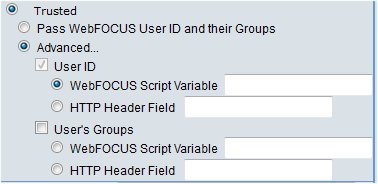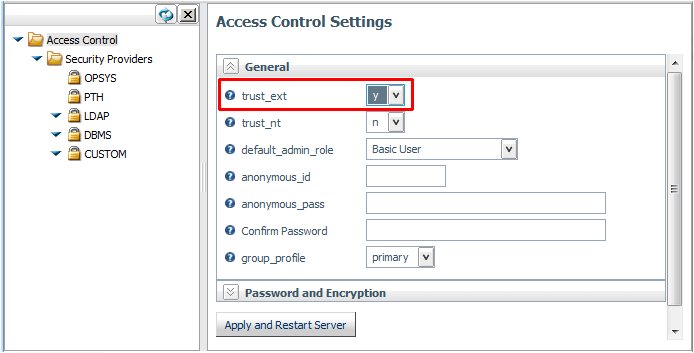SECURITY. Determines how WebFOCUS connects to the Reporting Server. The following are possible
SECURITY values:
Default. Is the initial value
for new nodes and represents the traditional behavior, where the
odin.cfg file does not contain a SECURITY keyword. In this case, WebFOCUS makes an explicit connection to the Reporting Server
with whatever user ID and password it has available for the request.
HTTP Basic. Configures WebFOCUS to
extract the user ID and password from the Authorization header. These
credentials are then used to make an explicit connection to the
Reporting Server. You should only select this option when your web
tier is performing Basic Authentication.
To verify that the
Authorization header is available to WebFOCUS, expand the Diagnostics node
in the Administrative Console and select HTTP Request
Info.
Kerberos. Configures WebFOCUS to
pass the Kerberos ticket for the user to the Reporting Server. This option
enables an end-to-end Single Sign-On solution from the desktop to WebFOCUS, from WebFOCUS to the Reporting Server,
and from the Reporting Server to supported relational DBMS systems.
When using this option, the Reporting Server must run in security
OPSYS mode. Kerberos must be specified in odin.cfg.
SAP Ticket. Enables
customers using Open Portal Services in SAP Enterprise Portal to
achieve Single Sign-On through WebFOCUS to a Reporting Server configured
with the Data Adapter for SAP. WebFOCUS passes along the MYSAPSSO
cookie of the user, created on SAP Enterprise Portal, to the Reporting
Server which validates it using the SAP security API.
Service Account. Allows you to
specify a user ID and password to be used for all connections to
the Reporting Server, as shown in the following image.

The service account credentials are
encrypted and stored in the SECURITY keyword of the odin.cfg file.
When defined, the service account overrides any other credentials
that may be presented to WebFOCUS for this Reporting Server
node, and all users connect to the Reporting Server using the same
credentials. This approach does not make it possible to identify
which user is running a given request on the server in Managed
Reporting deployments, and therefore is not recommended for them.
Trusted. Allows
you to connect to the Reporting Server with only a user ID. This
option is useful when no password is available for the user, and controls
can be placed on the server to ensure that connections from unauthorized clients
are rejected (for example, employing the server RESTRICT_TO_IP setting
or configuring a network firewall so that only a particular client
can connect to the server).
Note: To complete the configuration
of a trusted connection, you must enable the Reporting Server to
accept trusted connections. Step 10 instructs you how to configure
the Reporting Server once you have completed configuring the WebFOCUS
Client.
When you select Trusted,
the Pass WebFOCUS User ID and their Groups and Advanced options
become available, as shown in the following image.

If
you select Advanced, you can enter the script variable
and web server HTTP variable settings for User ID and the User’s Groups.
You can also specify the following optional parameters:
-
x
Security Object. For
any security option, an administrator can specify one or more HTTP
header names and/or cookie names as follows:
-
COOKIE. Specify
each HTTP cookie name separated by a comma (,). For example:
cookie_name1, cookie_name2
-
HEADER. Specify
each HTTP header name separated by a comma (,). For example:
header_name1, header_name2
Note: HTTP
cookie and header names must not contain commas (,) or colons (:),
since these are reserved delimiters.
REMOTE_USER is not a
valid value in the HEADER input box, since it is a special type
of HTTP header variable and its contents will not be sent to the
Reporting Server. Instead, specify the WF_REMOTE_USER variable.
-
HTTP_SSL. Enables
encrypted communication between the Client and the Reporting Server
HTTP listener. This option must be selected, if the HTTP listener
of the server is configured to use SSL.
If you are using a self-signed
certificate to enable HTTPS communication with a Reporting Server,
the certificate must be configured in the Java environment in which the
Client is installed. This enables HTTPS communication between the
Reporting Server and the following Client tools:
- Administration Console.
-
Developer
Studio Metadata tools,
such as the Synonym Editor and Create Synonym tool.
-
x
COMPRESSION. Turns
on data compression. Codes are: 0 (off) and 1 (on).
-
x
ENCRYPTION. Sets
data encryption ability and the cryptography symmetric method used.
Select one of the following options
from the drop-down list:
- 0 = off
- AES = Advanced Encryption
Standard. The AES selections are in the format
CIPHER(x)(-MODE)
where:
- CIPHER
Is AES128, AES192, AES256.
- x
Is optional and defines an RSA key length of 1024 bits.
- MODE
Is optional and is either Electronic Code Book (ECB) or Cipher
Block Chaining (CBC).
For example, AES256x-CBC is the AES
cipher, with 1024-bit RSA keys, and CBC mode. If the RSA or mode
is not specified, then the default values are used. The RSA default
value is 512 bits. The mode default value is ECB.
- IBCRYPT = user defined
IBCRYPT DLL is loaded.
-
x
CONNECT_LIMIT. Number
of seconds the client holds the pending connection. This is useful
in a cluster deployment to avoid a lengthy delay of failover response.
Other possible values are 0 (no wait) and -1 (infinite wait). -1
is the default value.
-
x
MAXWAIT. <query wait>[,<row
wait>]. Time the client waits before timeout. The first number
is the return time for any row. The second number (optional) is
the return time for rows beyond the first row. Time is in seconds.
-
x
DESCRIPTION. Description
for the Reporting Server node. This description displays in the
front-end tools.
Because you specified Client in step
4, proceed to step 8 (and skip step 7, which is used when Cluster
is specified).
 icon
on the Object Explorer toolbar.
icon
on the Object Explorer toolbar.


